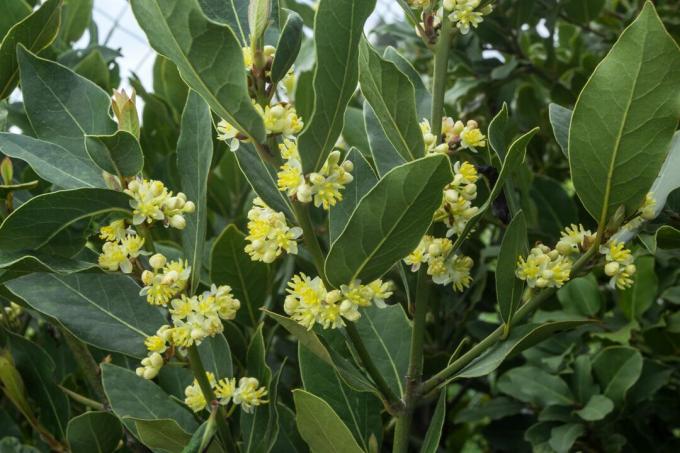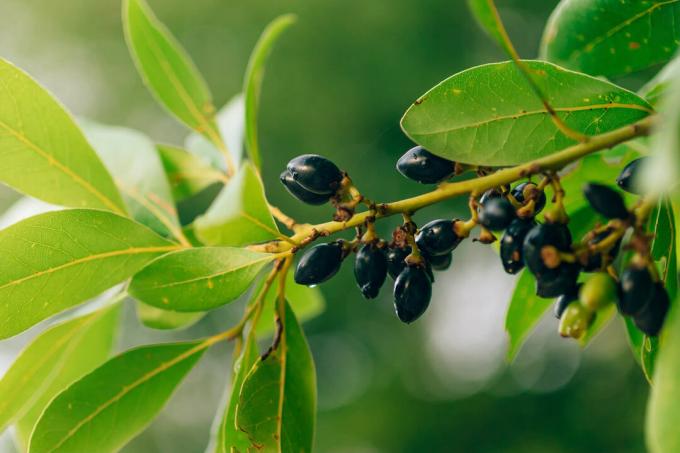The true laurel is very sensitive to cold. You can also harvest the spicy foliage in pots at home. We show how the cultivation succeeds.

Its leaves give many hearty dishes a suitable flavor - we're talking about the real thing laurel (Laurus nobilis). Thanks to a myth about the immortally in love god Apollo and the nymph Daphne, the evergreen shrub was even given the status of a saint. She turned into a laurel bush to escape from the intrusive Apollo. In the old Roman Empire, a laurel wreath as a headdress was an expression of power and prestige. But the winters here are too frosty for the cultivation of this noble spice. We will show you what the procedure for alternative cultivation in the planter should look like.
contents
- Laurel: The right location
- multiply laurel
- Water and fertilize bay leaves
- Overwinter laurel
- cut laurel
- Harvesting and storing bay leaves
Laurel: The right location
The real laurel originally comes from warm and sunny regions in the Near East. Accordingly, he prefers a sunny spot. But except in the warm regions of Lake Constance or the Lower Rhine, you don't really have to look out for a sunny spot in the garden bed. The true laurel usually does not survive the usually too cold winters unscathed. It is therefore worthwhile, to be on the safe side, to switch to growing in tubs. Choose a well-drained substrate. This can be ensured, for example, by a certain proportion of sand. In addition, it may well be rich in nutrients and have a good water storage capacity. All in all, a humus-rich, peat-based substrate with sand is ideal.

multiply laurel
The real laurel can be propagated by seeds and cuttings. Seeds are commercially available, but if you want to harvest them yourself, you must have a female plant. The female and male flowers of the laurel are on different plants (dioecious). You should proceed as follows when sowing laurel seeds:
- Only use fresh seeds for sowing
- Soak the seeds in water for two days and pretreat in this way
- then sow in sand
- in seed starch cover the sowing with sand
- ensure a warm environment (min. 20 °C).
- after 20 days seedlings should be visible

In the Propagation via cuttings shoots up to 20 cm long are taken in August or September. In a high humidity environment, the cuttings are rooted in a special substrate for propagation by cuttings.
Water and fertilize bay leaves
Not too much and not too little is the Pouring the laurel the motto. In order to reduce the high water requirement in summer, the laurel can be placed in a wind-protected corner. In long-lasting, hot summer periods, daily watering should also be avoided to protect the sensitive roots. It is better to give the thirsty plant the water it needs twice a week, but then vigorously. Usually you don't need to fertilize. When it comes to nutrients, the laurel is very frugal. However, potted specimens should be repotted into a larger pot in early spring about every two years. If here a good quality and fertilized substrate like ours Plantura organic universal soil is used, this is completely sufficient for the supply of nutrients.
Overwinter laurel
As already mentioned, the laurel is extremely sensitive to cold. In order not to take unnecessary risks, it should therefore generally be grown in pots in regions that are not frost-free. So you can easily bring it over the winter in a bright but frost-free place undamaged. However, watering should not be completely forgotten in winter either - if the laurel becomes too dry, it sheds its dry leaves and becomes bare. In this case, a radical pruning down to the main shoots can be conducive to fresh new growth.
cut laurel
A regular Topiary at the laurel is required to keep the spicy plant in shape. This should be done in March before new sprouting. The evergreen shrub can be brought into any shape and as a topiary can become a decorative element in the garden or on the terrace. However, you should take your time for the cut and work by hand instead of with a motorized hedge trimmer. A hedge trimmer cuts leaves that remain on the plant in an uncontrolled manner. This creates all entry points for threatening pathogens.
Harvesting and storing bay leaves
Bay leaves are harvested in autumn or spring. If the laurel grows abundantly in summer, it should not be harvested. Individual shoots can be removed by hand. The coveted, spicy leaves can either be used fresh or air-dried. Drying extends the usability by up to two years without having to forfeit the intensity of the aroma.
More information about Harvesting, storage and use of bay leaves see this article.

